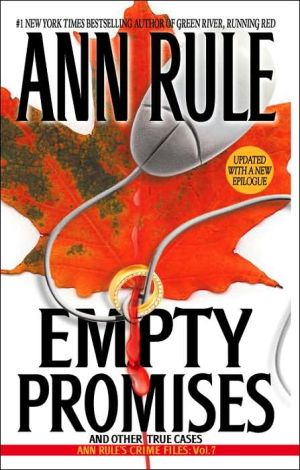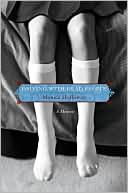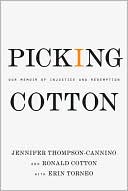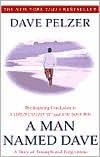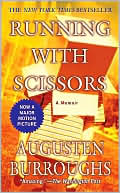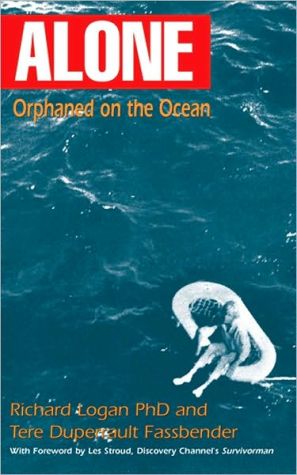Empty Promises and Other True Cases (Ann Rule's Crime Files Series #7)
MORE THAN 20 MILLION COPIES OFANN RULE'S BOOKS IN PRINT!\ In this unnerving collection drawn from her personal crime files, "America's best true-crime writer" (Kirkus Reviews) Ann Rule brilliantly dissects the convoluted love affairs that all too often end in violence.\ Expertly analyzing a shocking, headline-making case, Rule unmasks the deadly motives inside a seemingly idyllic marriage: a beautiful young wife, a rising star in America's top-ranked computer corporation, and a prosperous...
Search in google:
A beautiful wife, a rising star in a computer corporation, and a prosperous husband, the scion of a family building business, enter into a murky world of drugs, sordid sex, and con operations. Their fairy-tale romance ends in violent death... as with other cases presented here. Publishers Weekly The latest from respected true crime veteran Rule (And Never Let Her Go, etc.) walks readers through the tortured life and ugly murder of Sheila Bellush, a woman relentlessly pursued by her sexually obsessed ex-husband, Allen Van Houte. The crime scene is horrific: Bellush lies dead in the kitchen while her toddler quadruplets are left to walk naked through her blood. Bellush had long warned close friends that she feared her ex-husband's reprisals and went so far as to request "if I'm not here... find Ann Rule and have her write my story." Rule, in classic form, meticulously re-creates the prosaic lives of her characters, charting one woman's pleasantly humdrum existence undermined by a man bent on making a fortune though defaulting on bank loans and pedestrian cons, such as swindling family members. After he lured Bellush into his world of sexual play, she left him, and he hired a man to kill her. The subsequent fallout included a complex and lengthy inquiry by investigators. There are no surprises here for the reader, though some may enjoy Rule's examination of Van Houte's manipulative and predatory nature. Essentially, this account is too long for its limited subject matter. (Oct. 15) Forecast: Sixteen of Rule's 18 books have been bestsellers. Copyright 2001 Cahners Business Information.
Chapter One\ It was a Sunday afternoon, the last day of September 1990, when Judy Hagel began to feel uneasy. Usually she grew annoyed and exasperated when her son-in-law, Steve Sherer, phoned constantly to check on her daughter, Jami. He kept such close tabs on Jami that she seemed to move on an invisible tether. If she left home to visit her parents, he called to be sure she arrived within fifteen minutes, and then he kept calling to ask what she was doing, and very soon, of course, to insist that she come back home to their house in Redmond. If he had his way, Jami would never visit her family at all.\ But this afternoon, Steve didn't call — not for five hours. It was a record for him, and Judy found herself jumpy not at the ringing of her phone but because of the silence. She had expected Jami all day, and Jami never showed up. Judy was baby-sitting with Jami's little boy, Chris, and it wasn't like her daughter to stay away when she had promised Chris she would be back soon.\ Bellevue was once as far removed from Seattle in lifestyle and population as any of a number of small towns that dot the state of Washington. Fifty years ago it was a rustic hamlet on the other side of Lake Washington, where farms and blueberry bogs could be found just outside town. Before the first floating bridge connecting Mercer Island and Bellevue to the mainland in Seattle was completed in 1940, the little town was far off the beaten path. No one ever imagined Bellevue would become the third largest city in the state with its own mirror-windowed skyscrapers and upscale malls. After World War II, it became a bastion of affordable three-bedroom, bath-and-a-half houses that young marrieds could afford, and they flocked to the neighborhoods of Lake Hills and Eastgate. Returning veterans and recent college graduates found jobs at the Boeing Airplane Company. Young husbands went off to work and young wives stayed home and raised four children per family, long before anyone had heard about the population explosion. Appliances were avocado green, carpets were an orange shag that had to be raked as well as vacuumed, and tile floors were waxed faithfully once a week.\ It was a world of kaffeeklatsches, where wives shared recipes for frozen strawberry jam, onion soup dip, and complicated casseroles whose main ingredient seemed always to be Cheez Whiz. Yards sprouted gardens, and wives traded seedlings as frequently as they took turns baby-sitting. It was a time long before day care and two-income families. Bellevue seemed to promise that after the long dark war, everything was going to be all right. It was an ideal community in a halcyon era.\ But the decades that followed brought a tragic tumbling-down for many of the children whose future had seemed so bright. Bellevue, Washington, wasn't unique; drugs and more wars and assassinations and rock and roll and XXX-rated movies and videos and the erratic vicissitudes of fortune eroded family-based towns all over America. As Bellevue became a little grittier and far less inviolate, Jami Hagel's desolate destiny began to take shape, despite her family's struggle to save her.\ Judy and Jerry Hagel left tiny Carrington, North Dakota, in 1967 and headed for Washington State; Judy's two brothers lived there, and they said the job prospects were good. Judy and Jerry's oldest child, Randy, was five then and Jami Sue was almost three. A year later, Judy gave birth to twin boys, Rob and Rich.\ Rather than resenting all the attention the twins got, Jami was enthralled with them, and their birth gave her a tighter bond with her mother. Even though she was only three, she took care of the twins for her mother. "I wasn't expecting twins," Judy recalls. "I had no help, and Jami was there to help me. We had a little rocker, and I couldn't feed two babies at one time, so I'd hand one baby to her and she'd rock it to sleep. And I'd get the other baby and hand it to her. She was very helpful for me. She was always holding them — they were so little."\ And so was Jami. She was so petite as a child that she wore only size zero or size one. Her mother would seek out little specialty stores where there were clothes small enough to fit tiny Jami.\ Growing up in Bellevue as the only daughter in a family with three sons, Jami was in the thick of whatever her brothers were doing, despite her size. Randy was three years older than Jami, and her twin brothers, Rich and Rob, were three years younger. Jami looked like a little doll with bright brown eyes, luxuriant dark hair, and a "lovely smile," but she could give as good as she got from her brothers, who teased her, as all brothers do. Even when she was grown, Jami weighed only 95 pounds and stood just a smidgen over five feet tall. Jami was sweet-natured, but she wasn't afraid of anything. Judy and Jerry had raised her to be self-confident.\ Jerry Hagel and all of his children were involved in softball competitions early on. The whole family played in local leagues, and Jami was a tomboy. "She was small but feisty," her brother Rob recalled.\ Judy Hagel stayed at home to raise her children. She was the mother who was always available to drive her children and their friends to Lake Sammamish to swim or to the movies or to go horseback riding. Jami loved horses even more than baseball, and she and her friend Lori Stratton also loved to climb trees.\ Besides playing softball together, the Hagels spent their vacations together. They usually traveled back to North Dakota to visit their extended family during summer vacations. Christmas and all holidays and birthdays were special for them, and the Hagels' family album grew thick with photos of various celebrations. Judy loved her boys, but she delighted in her only daughter and the feeling was mutual. Judy and Jami shared secrets and discussed problems together.\ Judy couldn't imagine that life would ever be any other way. Jami was close to her father, Jerry, too. In photographs she is usually sitting near him. He treated her as if she were made of porcelain, and Jami always expected to marry a man like her dad.\ Jami Hagel was a nice girl who grew up to be a kind woman. A friend several years younger remembers how she idolized Jami. "She had a wonderful bedroom," the woman says, "with a rainbow theme. I thought it was so beautiful. Jami used to let me come in and look at her things, even though I was probably a little pest."\ As a teenager, Jami Hagel went to Sammamish High School, near Lake Hills in Bellevue. When she was a sophomore, she began going steady with Greg Coomes, who was very handsome and a year older than she was. They went together for five or six years, all through high school and beyond. Jami's family approved of Greg. The young couple had a monogamous, "very serious" relationship and eventually became lovers. "She was my first love," Greg would recall one day. "She was the first woman I was ever intimate with."\ Jami's high school world would have been the envy of any teenager. She had her own car, but she wasn't spoiled. She worked hard at her studies, and she was confident. Greg described her as having a strong sense of self. Most of her friends used the word "bubbly" or "outgoing and friendly" when they described her then — and later.\ Jami Hagel was unfailingly happy and never moody. While some teenagers go through angst and self-doubt, no one recalled that Jami was ever depressed. She was certainly not suicidal. She remained close to her family, particularly to her mother, a special relationship that Judy Hagel cherished.\ Jami and Greg's relationship did not, however, survive the changes that inevitably come with maturity. He graduated a year ahead of Jami and went to work for a hotel chain in Portland, Oregon, for six months. After that, he came back to the Seattle area to work at the Boeing Company. There was no big emotional breakup, but they simply saw each other less and less. "By 1986," Greg said, "we were down to just phone calls."\ Nevertheless, they remained friends, just as Jami kept her friendships going with most of the people who were part of her school years. June Young, a beautiful brunette, met Jami when they were in the ninth grade. "We were best friends. We were from the same background — we both had brothers," June remembers. "She had a great self-image," June says. "She was outgoing, happy, bubbly. Jami was a T-shirt-and-jeans girl."\ Jami and June continued to be best friends for a dozen years, even though they both encountered tragedies and problems. June went off to Western Baptist Bible College for a year after high school. When she lost her sister in a traffic accident, she came home to help her family bear the loss and took a job at an insurance company. June got married in 1988.\ Right after Jami graduated from high school, she found a job in the computer industry and moved into an apartment with another girl. She came home to live briefly when that living arrangement ended. After that, Jami got an apartment by herself in Redmond, about six miles from her parents' home.\ Jami Hagel's bond with her family remained strong; she called her mother three or four times a week and spent most weekends with them. Unlike many girls her age who can't wait to grow up and go through a period of proving how independent they are, Jami often dropped by to talk with her mother. If Judy was out in her garden or in the kitchen, Jami sat with her and talked about what was going on in her life. There were no secrets, and Judy could always find Jami when she needed to talk with her.\ But sometime in the mid-eighties, while Jami was living in her own apartment in Redmond, she met a man who was nothing like Greg Coomes. He was nothing like anyone Jami had ever dated, and her family and friends were a little surprised that Jami was attracted to him.\ Judy Hagel remembers the first time she ever saw Steve Sherer. He and Jami "drove up on a motorcycle," Judy says, "and he was very proud of the motorcycle because he had bought it from his winnings at the racetrack."\ Every other boyfriend that Jami had brought home to meet her parents had made an effort to be polite and friendly, but Steve seemed completely uninterested in them. The first time he met the Hagels, he strutted around as if he thought they should be impressed with him and his shiny new motorcycle. Almost as soon as Jami and Steve arrived, he was anxious to leave. Jami climbed on the bike behind him and they roared off, leaving the Hagels puzzled and worried. They told themselves that Jami couldn't really be interested in such a man.\ At twenty-four, Steven Frank Sherer was two years older than Jami. Despite his small stature, he had a powerful personality, more abrasive than pleasant much of the time, but he could also be completely charming. Steve told Jami early on that he was the son of a very wealthy family, and she noticed that he always seemed to have money. The money didn't matter that much to her; Steve's personality did. In the beginning, she liked his take-charge attitude.\ No one can predict the chemistry between two people, and for whatever reason, Jami Hagel and Steve Sherer soon began to date steadily.\ Steve claimed to be five feet nine, but he was closer to five seven. He carried himself like a much taller man. He often bleached his thick light brown hair so it turned blond in the sun and then combed it in a pompadour. His knife-like profile, while not handsome, was striking. He had a solid, muscular body, and he drove new cars, although he seldom seemed to work.\ Judy and Jerry Hagel saw nothing about Steve that erased their first impression of him, but they were smart enough not to voice their feelings to Jami; finding fault with Steve would just have made him seem more appealing.\ To a parent, Steve was anything but appealing. He was a spoiled rich kid whose rap sheet was longer than his job résumé, although Judy and Jerry Hagel didn't know about that when Jami first brought him home. He was also possessed of a truly ugly temper and just about every bad habit and addiction available. He drank, used marijuana and cocaine, gambled at racetracks and card rooms, and believed that women were basically chattels. When Jami answered his questions about men she had been with before she knew him, Steve was furious.\ Greg Coomes, her high school boyfriend, received a call in 1986 that at first seemed to be a wrong number. A man on the phone started swearing at him, using the worst gutter language. "He said he was going to kill me," Coomes recalled. "I had no idea who he was."\ Finally, Coomes heard a woman's voice and recognized Jami. She apologized for the caller and said he was her "lover" and the "person she lived with."\ In the beginning, shocked as she was by Steve's need to possess her, she also saw it as a sign that he was very much in love with her. Steve's jealousy made her feel happy and secure.\ Copyright © 2001 by Ann Rule
ContentsForeword Empty Promises Bitter Lake Young Love Love and Insurance The Gentler Sex The Conjugal Visit Killers on the Road A Dangerous Mind To Kill and Kill Again The Stockholm Syndrome
\ From Barnes & Noble"If anything happens to me, be sure and investigate it...and please have Ann Rule write the book." Sheila Blackthorne Bellush was eventually killed, and true-crime queen Ann Rule has written the book, perhaps the first ever penned at the request of a murder victim. Read it, weep, and keep the night light burning.\ \ \ \ \ Publishers WeeklyThe latest from respected true crime veteran Rule (And Never Let Her Go, etc.) walks readers through the tortured life and ugly murder of Sheila Bellush, a woman relentlessly pursued by her sexually obsessed ex-husband, Allen Van Houte. The crime scene is horrific: Bellush lies dead in the kitchen while her toddler quadruplets are left to walk naked through her blood. Bellush had long warned close friends that she feared her ex-husband's reprisals and went so far as to request "if I'm not here... find Ann Rule and have her write my story." Rule, in classic form, meticulously re-creates the prosaic lives of her characters, charting one woman's pleasantly humdrum existence undermined by a man bent on making a fortune though defaulting on bank loans and pedestrian cons, such as swindling family members. After he lured Bellush into his world of sexual play, she left him, and he hired a man to kill her. The subsequent fallout included a complex and lengthy inquiry by investigators. There are no surprises here for the reader, though some may enjoy Rule's examination of Van Houte's manipulative and predatory nature. Essentially, this account is too long for its limited subject matter. (Oct. 15) Forecast: Sixteen of Rule's 18 books have been bestsellers. Copyright 2001 Cahners Business Information.\ \ \ Publishers WeeklyAs in her previous true-crime accounts, Rule presents the facts of a murder case with all the intrigue, suspense and characterization of an accomplished novelist. Listeners learn how young Sheila Bellush met and married charismatic Allen Blackthorne, only to find that his charming exterior hid a ruthless, abusive swindler. After years of beatings and the birth of two daughters, Sheila left him and later remarried and had quadruplets. Alan also remarried and was hugely successful in business, but seemed obsessed with the need to punish Sheila for leaving him. When she was found brutally murdered, her toddlers crying and huddled around her body, investigators quickly found the culprits but were they sent by Sheila's ex-husband, or did they act on their own? Veteran narrator Brown strikes just the right note in her reading. Her voice is varied and expressive, not one-note, and pleasant to listen to. But apart from a touch of sympathy, she is not emotional and does not project herself into this nonfiction account. Instead, she steps back and lets the story tell itself, altering her voice slightly to indicate a quote and deepening it a bit if it's a man talking, but not offering character voices. Based on the Free Press hardcover (Forecasts, Sept. 17, 2001). (Jan.) Copyright 2002 Cahners Business Information.\ \ \ \ \ Library JournalCRIME Rule, a former police officer, investigates another cold-blooded murder. This one has an unusual origin: the doomed woman, suspecting her eventual demise, tells a relative to contact Rule in case she dies suddenly. Every Breath You Take points to the perpetrator, so it is the narrative skill that hooks us. From a much longer book, this abridgment's brisk pace is well calculated for audio, with Blair Brown's straightforward narration. The tale involves wife and child abuse, kinky sex (no details provided), and fortunes made and squandered on the wrong things. Will the evil man who specializes in colossal deception in the end slip through the legal net? Strong as fiction, these hard facts have been researched. Definitely recommended for popular true-crime collections. Gordon Blackwell, Eastchester, NY Copyright 2002 Cahners Business Information.\ \ \ \ \ Kirkus ReviewsBestselling true-crime specialist Rule (Bitter Harvest, 1998, etc.) certainly has her fans, but here her leering, hyperventilating style is merely distasteful. The story at its center is tragic. Sheila Bellush met handsome, slippery Allen Blackthorne, fell in love, and married him when she was much too young. Allen turned out to be trouble. He beat her, he cross-dressed, he ripped off her parents and everyone around him. Eventually, Sheila got away, but years later Allen tracked her down and had her murdered; he was caught, convicted, and went to jail. In between, Allen became a millionaire, Sheila had quadruplets, they both remarried, and everyone moved to San Antonio. Rule doesn't omit a single tawdry detail; between the two of them, Allen and Sheila have so many dissipated relatives and face so many assorted disasters that it's impossible to keep them all straight. Any sense of reality gets lost in this bloated, exaggerated, highly condescending retelling, which reads less like nonfiction than the script for a made-for-TV movie. Rule's claim that Sheila's sister sought her out and told her Sheila had wanted her to write about the case seems, to put it mildly, self-aggrandizing. Exploitative and sad. Literary Guild/Mystery Guild alternate selection\ \
